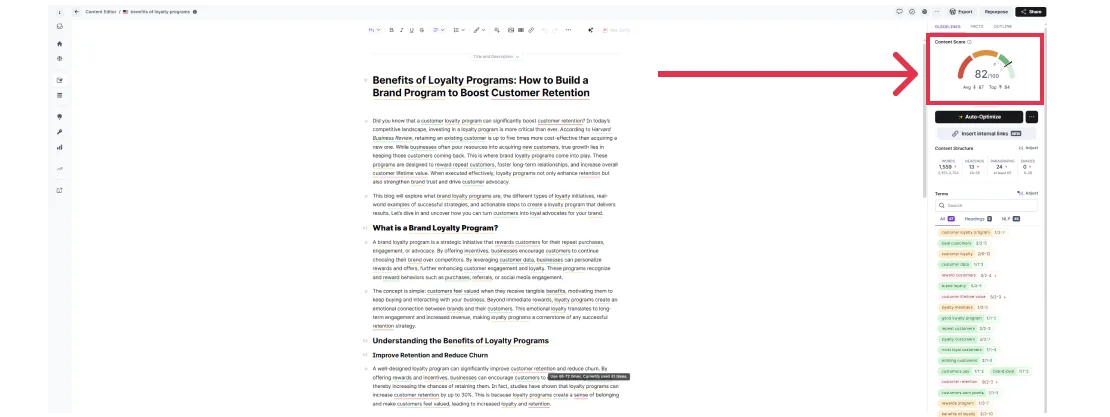
Here’s the mistake most eCommerce businesses make: they think search engine optimization success means constantly publishing new content for search engine visibility, failing to consider search intent. More blogs, more pages, more important keywords. But what if everything you need to boost your keyword rankings is already sitting on your site — just poorly optimized?
Content optimization is the secret weapon hardly anyone talks about. Creating high-quality, engaging digital content is a critical aspect of content optimization. Using the best content optimization tools is faster than creating from scratch, cheaper than launching new campaigns, and incredibly effective when done right. Yet so many brands ignore it, leaving outdated or underperforming content to collect dust — and drag down their visibility in the process.
Think of it this way: if Google can’t understand your content or detect the search intent, or if users bounce the second they land on it, no amount of fresh posts will save you. Optimization bridges that gap. It sharpens your message, improves your structure, and turns dead weight into revenue-driving assets. A content editor can play a crucial role in enhancing content optimization by refining content through iterations to meet SEO standards. In this blog post, we’ll break down exactly how to optimize your existing content for immediate impact and long-term growth — covering on page SEO basics, conversion strategies, interlinking tactics, and more.
Quick Wins: Optimizing Content That Delivers Immediate Results
You don’t need to start from scratch to see better search engine results. Begin with your title tags — make them clearer, sharper, and more clickable. It is important to identify a target page for optimization to ensure your efforts are focused and effective. Next, tighten your meta descriptions and target keywords in descriptions to improve your click-through rate in search engine results pages. Strong CTAs should be placed above the fold to drive faster actions, and your formatting matters just as much: short paragraphs, bullet points, and bolded key info help users (and search engines) scan your content more easily.
Now for one of the most underrated search engine optimization moves: internal links. Linking to high-priority pages or related blog content keeps users engaged longer, improves bounce rates, and helps search engines better understand your site’s structure. Want to target SERP features like featured snippets? Answer common questions directly in 1–2 sentences or use structured elements like tables and lists. Don’t forget to add schema markup — which is a type of structured data that helps search engines better understand your content. Adding schema types like FAQ, product, or customer reviews can trigger rich results in Google, such as star ratings, dropdown answers, or product details directly in search listings. Updating your website content to keep it fresh and relevant is crucial for attracting and retaining visitors. Once your content’s updated, re-promote it via email and social media for an immediate spike in more organic traffic.
Long-Term Strategies for Sustainable Traffic
While quick wins get your content moving, real growth comes from playing the long game. That starts with building content that reflects E-E-A-T: experience, expertise, authoritativeness, and trust. Include detailed insights, relevant keywords, real-world experience, up-to-date sources, and author bios to show both users and search engines that your content is credible. Identifying content gaps as part of the optimization process is crucial. Next, focus on topic clusters — group related blogs under a central pillar page. This structure not only helps search engines understand your content but also improves internal linking and user navigation for your target audience.
Don’t forget to optimize for long-tail and semantic keywords that align with how users actually search. Refresh internal anchor text to better match target terms and ensure backlinks point to the right pages. Use tools like Google Search Console, Ahrefs, and SurferSEO to monitor rankings, traffic, and engagement. When something starts to slip due to keyword stuffing, update it — optimization is an ongoing process. Utilizing SEO content optimization tools is essential for monitoring and improving content performance.
The Power of Interlinking: More Than Just SEO Juice
Interlinking isn’t just an SEO best practice — it’s one of the simplest ways to increase website traffic, engagement, and authority across your entire site. By connecting related pages and blog posts, you help distribute link equity from high-traffic content to newer or lower-ranking pages, giving them a performance boost and increasing organic traffic. Additionally, link building through backlinks from external websites plays a crucial role in improving search engine rankings. At the same time, internal links keep users moving through your site, reducing bounce rates and increasing average session duration — two positive behavioral signals for Google.
It also helps with crawlability. When your internal linking structure is strong, search engines can more easily discover and index important pages. Just as important: use descriptive anchor text to reinforce keyword relevance and help readers, including screen readers, know what to expect on search engine results pages. Original research in your content can generate backlinks from other sites, which can significantly enhance your SEO performance. And don’t just link at random — be intentional. Link to related blogs, product categories, or service pages to guide your visitors along a natural journey that aligns with both their interest and your goals. Emphasizing content quality and writing high-quality content is key to achieving better SEO results.
Best Content Optimization Tools
To make your content optimization process smarter and more strategic, start with tools like Clearscope, SurferSEO, or MarketMuse. Using these tools is crucial to achieve positive SEO results. These platforms score your content based on keyword usage, readability, and competitive benchmarks — helping content marketers identify what’s missing and how to close the gap with higher-ranking competitors. Platforms like SurferSEO are especially helpful because they show where your content currently stands and where it needs to be to improve your search engine rankings, considering factors like keyword difficulty.
 SurferSEO Content Score Example
SurferSEO Content Score Example
Beyond individual pages, it’s important to look at the bigger picture. Run a full content audit using tools like Screaming Frog, SEMrush, or Google Search Console to uncover thin content, broken internal links, or outdated pages holding your site back from effectively publishing content. For fresh content ideas, explore Google Trends and the “People Also Ask” box to tap into real-time search queries. Additionally, using a content template can help structure your optimized content by leveraging data from top-performing SERP competitors. These research-driven insights make sure your optimization strategy is both data-informed and aligned with your target audience’s search behavior. By optimizing content effectively, you can achieve higher rankings in Google’s search results and ensure your main keyword is prominently featured.
Conclusion: Create Less. Optimize More.
When it comes to SEO, content optimization is one of the most underrated strategies for improving content’s performance and achieving faster wins and long-term compounding growth. Instead of constantly pushing out new blogs or landing pages, take a closer look at your content creation process and what’s already on your site. Small but strategic updates — like refining your CTAs, improving your internal linking, or optimizing for featured snippets — can unlock major performance gains in your content marketing effort with less effort.
Don’t underestimate the value of what you’ve already published. With the right content optimization tools, structure, and mindset, your existing content can become a powerful driver of traffic and conversions in your content marketing strategy. Effective content optimization can also significantly enhance search engine performance, leading to increased conversions. Not sure where to start? MAKDigital offers full content audits and optimization services to help you create SEO-friendly content, rank higher, and convert better. Keep in mind to optimize images, use meta tags effectively, and analyze your efforts using Google Analytics. This will ensure that your web pages are not only engaging but also aligned with your content strategy and primary keyword goals.
In conclusion, by focusing on optimizing what you already have, you can achieve higher search engine rankings, attract more organic traffic, and build a sustainable online presence. Remember, quality over quantity is the key to a successful content strategy. So, start optimizing today and watch your content’s performance soar!

 Eashan Mehta
Eashan Mehta






